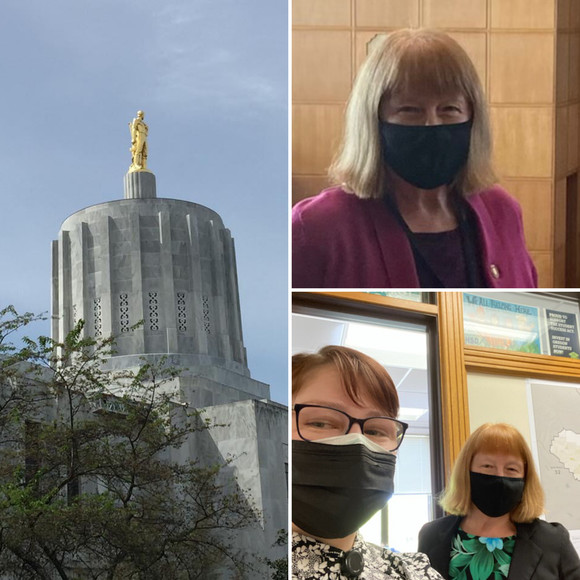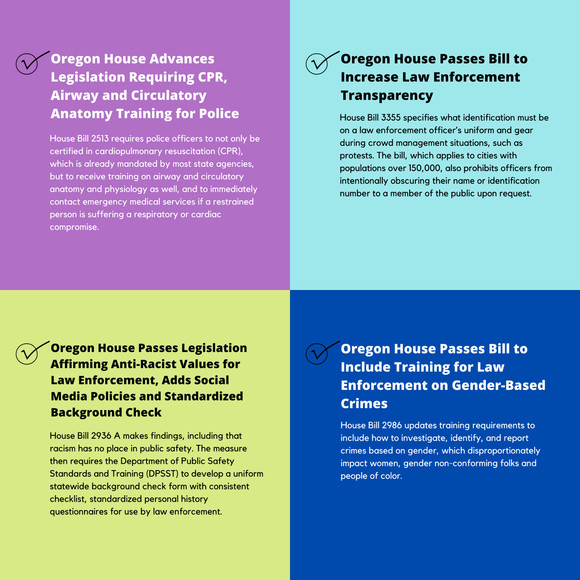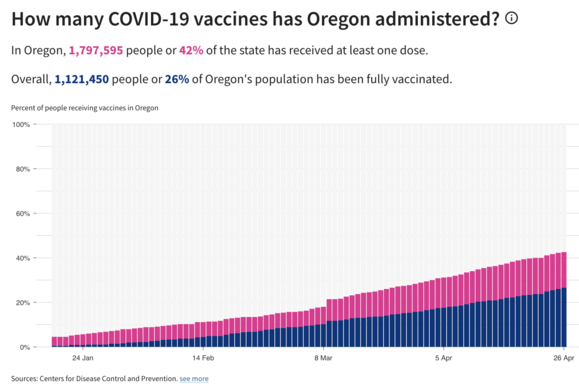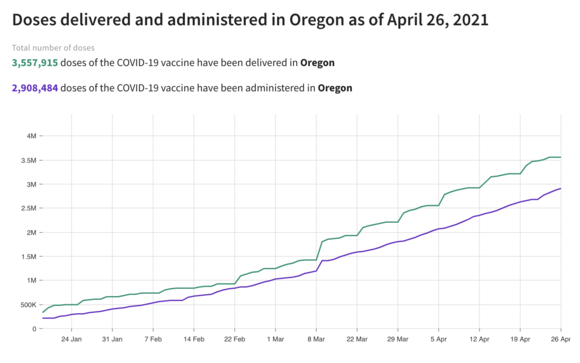|
Dear Friends and Neighbors,
After a week off the Floor due to a positive COVID case, we were back to business on Monday and voted on very important policing reforms - please see my bill section below for more information. On Monday, one of my top priority bills on Transportation Accessibility (HB2985) passed the Senate 24-3 after passing unanimously in the House. It now heads to the Governor's desk to be signed. This bill will increase representation for those with mobility issues on ODOT advisory boards. Another one of my bills, HB3185, is up for a vote tonight on the House Floor. This bill is an environmental 'fix it' bill that provides statutory language specifying that material removed from traditionally maintained agricultural channels during maintenance activities cannot be placed on or in undisturbed wetlands, either temporarily or permanently. This was the intent of the original bill and this concept is also in program rules. The bill does not change the original purpose or guidelines. I look forward to reporting back to you about its successful passage.
 |
2021 Session Committee Assignments
Joint Committee On Ways and Means
Joint Committee On Transportation - Co-Chair
House Committee On Agriculture and Natural Resources - Vice Chair
Joint Committee On the Interstate 5 Bridge - Co-Chair
Joint Committee On Ways and Means Subcommittee On Education - Co-Chair
2019-2020 Joint Emergency Board
Watch all Oregon State Legislature Live-Streams and Meetings HERE
Track all 2021 Session Bills HERE
 |
|
Instructions for how to testify:
English instructions here
Aquí están las instrucciones
|
|
I was proud to vote for the following bills on Monday, all of which successfully passed the House and are now headed to the Senate:
Wildfire relief bill: HB 3272 A - This bill strengthens insurance coverage benefits and flexibility, providing consumers with additional protections. The bill looks to support homeowners who are rebuilding after natural disasters, and in this case, the 2020 wildfires. The bill requires insurers to allow homeowner insurance policyholders at least 24 months of additional living expense, subject to policy limits, and at least 24 months to repair, rebuild, or replace damaged property if the property is located in an area subject to a declared state of emergency. The bill also requires insurers to provide 12 additional months of additional living expenses and time to repair, rebuild, or replace if the homeowner encounters unavoidable construction-related delays. It also prohibits policy from limiting or denying payment on the basis that the policyholder chose to rebuild in a new location or to purchase an existing structure in a new location when the insured structure was a total loss.
Indigenous People's Day: HB 2526 - I am proud to be a sponsor of this bill which designates the second Monday of October of each year as Indigenous Peoples' Day. This bill looks to honor and recognize the native people of the state, including the Oregon Tribes, by memorializing the many histories, cultures, contributions, and lives.
Police accountability bills: The House passed a series of police accountability and reform bills with bi-partisan support:
-
House Bill 3164 A: This bill, of which I am a sponsor, limits the circumstances under which a person could be charged with interfering with an officer. The bill aims to prevent unjustifiable arrests for all Oregonians, but especially BIPOC communities and people experiencing homelessness who are disproportionately impacted. The bill, brought to the floor at the request of the ACLU, will also protect reporters who are simply trying to do their job. (More details available here)
-
House Bill 2513 A: This bill requires police officers to not only be certified in cardiopulmonary resuscitation (CPR), but also receive training on airway and circulatory anatomy and physiology as well, and to immediately contact emergency medical services if a restrained person is suffering a respiratory or cardiac compromise. (More details available here)
-
House Bill 2929 A: This bill, of which I am a sponsor, strengthens police misconduct reporting requirements for police by requiring officers who witness misconduct or minimum standard violations to report the violation within 72 hours to a direct supervisor, a superior officer in the reporting officer’s chain of command, or the Department of Public Safety Standards and Training (DPSST). (More details available here)
-
House Bill 2936 A: This bill affirms anti-racist values for law enforcement, adding social media policies and standardizing background checks. Requires DPSST to create a statewide uniform background check for law enforcement units to implement during hiring processes. (More details available here)
-
House Bill 2986: This bill supports training police to investigate, identify and report crimes motivated by prejudice based on gender. Specifically, the bill requires the Board on Public Safety Standards and Training to ensure that police officers and certified reserve officers are trained to investigate, identify and report crimes motivated by the perceived gender of victim. (More details available here)
-
House Bill 3047 A: This bill creates anti-doxing legislation that creates cause to sue for damages if a person’s information is released without their consent, and results or could result in stalking, harassment, or injury. (More details available here)
-
House Bill 3273 A: This bill protects Oregonians’ privacy. Upon request, publish-for-pay sites would have 30-days to remove or destroy a booking photo, and could charge no more than $50 for the service. Additionally, HB 3273 A limits the circumstances under which law enforcement agencies can release booking photos. The photo can still be released to other law enforcement entities and can be distributed for the purposes of locating a fugitive or suspect. (More details available here)
-
House Bill 3355 A: This bill creates transparency by specifying what identification must be on a law enforcement officer’s uniform and gear during crowd management situations, such as protests. The bill, which applies to cities with populations over 150,000, also prohibits officers from intentionally obscuring their name or identification number to a member of the public upon request. (More details available here)
-
House Bill 3059: This bill, of which I am a sponsor, keeps police from abusing powers by providing more clarity in how to manage “unlawful assemblies.” Gives bureaus more flexibility to not arrest non-violent protestors when an “unlawful assembly” is declared. (More details available here)
 |

Oregon to get 6th seat in Congress
*This is a summary of an article from OPB.
Following a decade of robust population growth, Oregon will receive a new congressional seat for the first time in 40 years, the U.S. Census Bureau announced on Monday.
According to the 2020 census, the state’s resident population was 4,237,256 as of April 1, 2020. That’s a 10.6% increase over the 3,831,074 that officials calculated a decade before. The population figures used to determine representation are slightly larger, including both people living in Oregon and some federal employees overseas who normally reside in the state.
The increase, weighed against the slower growth or even population declines in other states, means Oregon now gets a marginally greater slice of the congressional pie: six members of the U.S. House of Representatives rather than the current five. Under the reapportionment process, the country’s 435 congressional seats are rejiggered every 10 years to account for population trends.
Other states gaining seats this year include Texas, which will receive two, and Colorado, North Carolina, Florida and Montana, which are gaining one. California, Illinois, Michigan, New York, Ohio, Pennsylvania and West Virginia lost seats. New York fell just 89 residents short of maintaining all of its 27 seats, the Census Bureau said.
The U.S. population in total rose to 331,449,281, a 7.4% increase that amounts to the slowest growth since the 1930s.
A new spot in Congress had long been predicted in Oregon, which narrowly missed out on a sixth seat after the 2010 census. Now that it’s official, lawmakers face the likely contentious process of splitting the state into six districts.
What that map will look like is anyone’s guess. Currently, four of the state’s five U.S. House members are Democrats. Some observers have suggested it’s likely a new seat will lean Republican, but exact boundaries are far from certain and it can be tough to predict how any new set of boundaries will shake out in the long term.
The dynamics that will go into shaping those maps have also changed significantly in recent weeks.
With sweeping control of state government, Democrats had been poised to dominate redrawing not only congressional maps, but boundaries for the state’s 90 legislative districts that will last for the next decade.
But in order to stop Republicans from using delay tactics to slow bills, House Speaker Tina Kotek, D-Portland, has agreed to give the GOP an equal say on a House committee tasked with redrawing maps. Senate President Peter Courtney, D-Salem, is expected to do the same for the Senate Redistricting Committee, though he has refused to confirm or deny that.
Even parity in one chamber, however, gives Republicans what amounts to veto power. If lawmakers are split along party lines over new maps in committee, those maps can’t pass out for a full vote. Such a deadlock would ensure lawmakers are unable to pass their own plan by a late September deadline.
If lawmakers fail to find agreement, responsibility for drawing new state House and Senate boundaries would fall to Secretary of State Shemia Fagan, a liberal Democrat. But a new congressional map would become the purview of a panel of judges, in a process that has never been tested.
The possibility that judges will ultimately control congressional boundaries has led some national observers to conclude that Oregon’s maps could turn out far different than if Democrats had maintained full control.
Monday’s announcement marks the first time Oregon has received a new congressional seat since the 1980 census. Along with the new seat, the state will also receive another electoral college vote, bringing the state to eight reliably Democratic votes in presidential elections.
The official population data issued Monday also has a role in determining the size of state House and Senate seats. Each Senate district drawn up this year will need to include roughly 141,242 people, with consideration also taken into preserving communities of interest and other factors. Each House district will need to include roughly 70,621 people.
Since growth in the state has occurred unequally, meaningful changes are likely in both House and Senate maps. Oregon’s growth in the last decade has centered primarily on the Portland metro area — especially Washington County — along with Bend, meaning more electoral power is likely to be centered in those areas. At the same time, portions of Eastern and Southern Oregon have seen slower population growth than the state as a whole, meaning they will have less representation.
|
Governor Kate Brown Urges Oregonians to Get Vaccinated, 15 Counties Qualify for Extreme Risk Amid Rapid Surge in COVID-19 Cases and Hospitalizations
-
Vaccinations key to staying safe, fully reopening the economy: “There are appointments available right now all across the state.”
- Governor partnering with Oregon Legislature for $20 million emergency relief package to immediately aid businesses in Extreme Risk counties
-
County health and safety restrictions to be evaluated weekly, with counties remaining in Extreme Risk for a maximum of three weeks
(Salem, OR) — Due to the rapid spread of COVID-19 in Oregon, Governor Kate Brown today announced updates to county risk levels under the state’s public health framework. With hospitalizations rising above 300 people statewide, threatening to overwhelm doctors and nurses, 15 counties will move to the Extreme Risk level effective Friday, April 30 through Thursday, May 6. In addition, nine counties will be in the High Risk level, four at Moderate Risk, and eight at Lower Risk. A complete list of counties and their risk levels is available here.
“If we don’t act now, doctors, nurses, hospitals, and other health care providers in Oregon will be stretched to their limits treating severe cases of COVID-19,” said Governor Brown. “Today’s announcement will save lives and help stop COVID-19 hospitalizations from spiking even higher. With new COVID-19 variants widespread in so many of our communities, it will take all of us working together to bring this back under control.”
Governor Brown is partnering with lawmakers to approve a $20 million small business emergency relief package to immediately support impacted businesses in Extreme Risk counties through the commercial rent relief program.
In an effort to speed up the return to normal business operations, county COVID-19 data will be evaluated weekly for at least the next three weeks. Any updates to county risk levels next week will be announced on Tuesday, May 4 and take effect on Friday, May 7. Counties that improve their COVID-19 metrics will have the opportunity to move to a lower risk level. Counties will remain in Extreme Risk for a maximum of three weeks.
Three-week limit placed on Extreme Risk level, Portland-area hospitals to closely monitor capacity
Under the Risk Level framework, counties move to (or remain in) Extreme Risk when they meet the county metrics for case rates and percent positivity, and Oregon meets statewide hospitalization metrics: COVID-19 positive patients occupying 300 hospital beds or more, and a 15% increase in the seven-day hospitalization average over the past week.
Counties will stay in Extreme Risk for a maximum of three weeks, and will be able to move to a lower risk level sooner if their COVID-19 case rates are brought down in the intervening weeks, or if Oregon moves below 300 statewide hospitalizations or the seven-day hospitalization average percent increase goes below 15 percent.
The Governor has also worked in partnership with Portland metro-area hospitals to ensure systems are in place to closely monitor and manage hospital capacity. Health systems in the Portland area are using the coordinated system developed at the beginning of the pandemic to manage hospital surge capacity, bed space, essential services, and non-urgent procedures as needed over the next three weeks in order to preserve hospital beds and critical care capacity.
If, after three weeks, Oregon still exceeds statewide hospitalization metrics and one or more counties still meet the case rates and percent positivity for Extreme Risk, the Oregon Health Authority will evaluate why and make recommendations to the Governor’s Office.
OHA clears health care providers to resume Johnson & Johnson vaccinations
Oregon health care providers and pharmacies may resume administering the Johnson & Johnson COVID-19 vaccine if they can ensure patients or their caregivers are informed about the benefits and risks of the vaccine in their primary language according to Oregon Health Authority (OHA).
On April 13, the federal Centers for Disease Control and Prevention (CDC) recommended a pause on use of the Johnson & Johnson vaccine following reports of rare and serious blood clots in a small number of people, out of the approximately 7.5 million people who’d been vaccinated at the time.
On Friday, April 23, the Food and Drug Administration lifted the pause, with a warning about the potential for rare blood clots for women under age 50.
The Western States Scientific Safety Review Workgroup met on Saturday, April 24, and determined that the Johnson & Johnson vaccine is “generally safe and effective” and use could resume as long as there is information available for patients to make informed decisions. Information about the vaccine needs to be culturally appropriate and easy to understand, in the patient’s primary language.
According to OHA’s guidance to health care providers, “Recipients of the Johnson & Johnson vaccine should be made aware of this rare potential risk of blood clots within the first three weeks of vaccination.”
Updated fact sheets including this warning have been approved by the FDA, including the Fact Sheet for Healthcare Providers administering vaccine and the Fact Sheet for Recipients and Caregivers. These fact sheets also include information on when to seek medical attention.
You can read more about this decision in the news release.
I’m fully vaccinated. Why do I have to continue safety precautions?
It’s been a tough year for everyone and so many of us are, frankly, tired. Tired of not seeing our loved ones. Tired of wearing a face covering. Tired of staying close to home. But we are so close to helping end the pandemic! Even if we are fully vaccinated, many other people are not. And until we reach the point where COVID-19 can no longer easily spread, we need to keep practicing the proven safety precautions.
The fact is that COVID-19 is a new virus. That means health experts are still learning how effective the authorized vaccines work against the virus and emerging variants. Early data shows the vaccines work very well against the virus, but could be less effective against some emerging variants. Experts are also monitoring how well the authorized vaccines keep people from spreading the disease, and how long vaccine protection lasts.
The good news? We know what we must do to help stop the spread of COVID-19. Wear a face covering. Watch your distance, wash your hands often and stay home when you’re sick. And get vaccinated when you are able. Create an account at Get Vaccinated Oregon to find out where you can get vaccinated.
If you have questions about what you can do after vaccination, potential side effects and second doses, join Oregon Health Authority (OHA) for a Facebook Live, Wednesday, April 28 at noon, to have these and other post-vaccination questions answered by our experts.
 |

Washington Co. Vaccine Information:
There is still less vaccine supply than necessary to meet the needs of everyone who is eligible and wants the vaccine. We ask for your continued patience until we get more vaccine (coming soon!).
Please do not double-book or no-show for your appointment.
Oregon Convention Center: Sign up here and you will be sent an invitation when a vaccine is available to you. Names are selected at random from eligible pool.
OHSU drive-thru clinics at Hillsboro Stadium and PDX Airport Red Economy Lot: Schedule online via OHSU's tool. New appointments are released at 9 a.m. on Mondays and Thursdays at the very least. Other days are often added at the last minute, so you might want to visit OHSU's page weekdays at 9 a.m. if you are looking for an appointment.
Washington County-Sponsored Community Clinics: April 30-May 1: Drive-thru clinic at Nike campus in Beaverton. In partnership with Tualatin Valley Fire & Rescue, Nike and City of Beaverton. Pfizer vaccine. Schedule appointment here.
Local pharmacies:
On April 23, the Food and Drug Administration lifted the pause on the use of the J&J vaccine, with a warning about the potential for rare blood clots for women under age 50. The Western States Scientific Safety Review Workgroup also found that the Johnson & Johnson vaccine is “generally safe and effective and that the resumption of its use is warranted once culturally and linguistically appropriate patient and provider educational materials in plain language that support informed decision-making are available.” The FDA has provided an updated Q&A about the J&J vaccine.
The Oregon Health Authority says that Oregon health care providers and pharmacies may resume administering the Johnson & Johnson COVID-19 vaccine if they can ensure patients or their caregivers are informed about the benefits and risks of the vaccine in their primary language.
|
 |
 |
 |
National Numbers:
-
Confirmed Cases: 31,924,610
-
Deaths: 569,771
- These national numbers come from the Centers for Disease Control and Prevention. You can view their national and state by state data here.
Oregon Status Report:
- Oregon now has 181,321 total cases (confirmed and presumptive) of COVID-19.
- Today we have 2,201 new confirmed and presumptive cases, and 10 new deaths.
- A total of 2,486 Oregonians have died from COVID-19 (previous daily case updates from OHA here)
- Washington County has 24,189 confirmed cases, including 229 deaths.
-
The Oregon Health Authority recently provided a Public Health Indicators Dashboard to enable communities across Oregon to monitor COVID-19 in the state. The dashboard, which will be updated weekly on Thursdays, provides a transparent report that presents complex epidemiological data in an interactive, easy-to-understand way on a state and county level
Quarantine guidance updated to prevent the spread of COVID-19
The surge in COVID-19 cases and increase in hospitalizations in Oregon are a concern right now. Oregon Health Authority (OHA) has updated recommendations for the length of quarantine to 14-days. We want to remind you that quarantining is an important tool to prevent the spread of COVID-19 to others.
Here’s what you need to know about the quarantine guidance:
- If you are unvaccinated or partially vaccinated and you are exposed to someone with COVID-19 you should quarantine for 14 days.
- People who have been exposed to a person with COVID-19 are not required to quarantine if they have been fully vaccinated.
- A person is considered fully vaccinated if it has been two weeks or longer since they received the final dose of their vaccine series and they do not have symptoms of COVID-19.
Revised guidance for this new recommendation is being finalized and will be available on the OHA webpage.
 |

Fall 2021 Planning - Hillsboro Schools
What will happen in the fall is a question at the top of everyone’s mind right now, so we wanted to share our current plans with you.
We intend to offer full-time in-person instruction, five days per week in the 2021-22 school year. HSD will continue following the requirements, guidance, and advice issued by the Governor, Oregon Health Authority, and Washington County Public Health. However, we believe that many of the restrictions currently in place will change prior to September 1, 2021, therefore allowing the return to a full schedule of in-person learning this fall.
There will be three instructional options for students in the 2021-22 school year:
- Attend your neighborhood school - available PreK-12
- Enroll in Hillsboro Online Academy (HOA) - available K-12
- Enroll in our new CDL-only option - available K-8
- The CDL-only option will be feeder-based, not school-based. Students will not be learning alongside their peers who are attending in person, as they currently are in the Hybrid model.
- Specific staff will be assigned to teach the students in CDL-only. Those staff will only be teaching CDL, they will not be expected to teach students both in person and in CDL.
Once an option has been selected, students will need to remain in that setting for at least the semester. Additional details about the process and timelines for selecting HOA or the CDL-only option will be shared in the coming weeks.
Please note that if you have a child you wish to place in an HSD preschool program in the fall, they must meet eligibility requirements and you must fill out the Preschool Interest Form in advance.
|

Message from Superintendent Parker
Dear FGSD Families,
In the wake of events surrounding the verdict in the Derek Chauvin trial earlier this week, we recognize this is an important moment in history. We also know that it is a step in the direction of change in our society. I want to confirm that as a district, we will continue to hold to our district maxims. We “Care Deeply” about our students and our staff. We will continue to “Stand Strong” and make the necessary changes to ensure our district is a place where our students and staff feel safe, welcomed, heard and seen.
Respectfully,
Dave Parker
Last Day of School
As a point of clarification, the last day of school will be Tuesday, June 15th. However, as we are in hybrid learning, it will be handled as follows:
- Cohort A will be in person on Monday, June 14, while Cohort B and those participating in CDL will be online.
- Cohort B will be in person on Tuesday, June 15, while Cohort A and those participating in CDL will be online.
- Wednesday, June 16, will be a day for all students to turn in their technology and other materials. Building administrators will share more details.
- Thursday and Friday, June 17-18, will be teacher work days.
Long Range Facilities Plan (LRFP)
The LRFP is a comprehensive summary of the district’s facility needs in the future and assists the district in strategically managing facilities over time. It provides detailed information regarding accommodating educational programs, future enrollment and documents the condition of the district’s current facilities. It also explores modernization, additions, replacements and new construction.
With the help of a community focus group, the district has produced a draft LRFP plan and is seeking the broader community opinion. We will be holding two virtual community meetings on May 12 and 17 (6-8pm). Meetings will be held in English and Spanish. We invite all community members to attend and provide their feedback, insight and opinions. In the coming days we will be sharing the links to the digital meetings.
Kinder Roundup
Registration for kindergarten will begin the week of April 26th. Each elementary school will have a dedicated online form for families to complete with preliminary information. Once that form is filled out, the schools will mail the family a registration packet to complete and return. Please visit the district website for links to school forms as well as dates and times for virtual parent information nights.
Annual FGHS Plant Sale
The high school is having their annual plant sale. Due to COVID and not having students on campus, they will have their normal hanging baskets and only a very small number of succulents, tomato starts and bedding plants. The sale will be held behind the tennis courts on April 29-May 1 and May 6-May 8 from 10 a.m. to 5 p.m. each day. Masks are required. Checks and credit cards are accepted.
|
 |
Washington County is in full bloom!
Wildfire Resources:
OEM has put together this list of contacts to help speed up the process of replacing these documents:
-
Green cards: Phone (800)-375-5283; Website: www.uscis.gov
-
Medicare cards: Phone: (800)-772-1213; (TTY) (800)-325-0778 Website: www.medicare.gov
-
Military records Phone: 866-272-6272 Website: www.archives.gov/contact/
-
Passport Phone: 877-487-2778; (TTY) 888-874-7793 Website: travel.state.gov
-
Social Security card Phone: 800-772-1213; (TTY) 800-325-0778 Website: www.ssa.gov
-
U.S. Savings Bonds Phone: 844-284-2676 Website: www.treasurydirect.gov
-
U.S. tax returns Phone: 800-829-1040 Website: www.irs.gov
-
Birth, death, marriage, domestic partnership, divorce certificates Phone: 888-896-4988 Website: www.oregon.gov/oha/PH/Birthdeathcertificates
-
Driver’s license, auto titles and registration, ID cards Phone: 503-945-5000 Website: www.oregon.gov/odot
-
SNAP (Oregon Trail Card) Website: www.oregon.gov/DHS/Assistance/Food-Benefits
-
State taxes (Oregon Dept. of Revenue) Phone: 503-378-4988 or 800-356-4222 TTY: All relay calls are accepted. Website: www.oregon.gov/dor
-
Real estate and property - Contact your county government.
-
Credit cards - Contact your credit card company directly.
-
Credit reports from Equifax, Experian, TransUnion Phone: 877-322-8228 Website: www.annualcreditreport.com
-
Insurance documents - Check with your insurance agent.
-
Medical records - Call your doctor or your medical insurance company; medical and prescription records are tracked electronically.
The Governor’s office has put together a Wildfire Resources page that you can access from the Governor’s home page. It has links to many of the most important updates about the status of fires and resources for evacuees. This website will be updated regularly.
Legal Resources: Oregon State Bar’s Lawyer Referral Program, Oregon lawyers, through the Oregon State Bar, are partnering with FEMA and the American Red Cross to provide legal assistance on FEMA claims, contract claims, insurance claims, landlord-tenant matters and more.
The Department of Forestry’s Wildfire Response and Recovery Overview has ongoing updates about firefighting efforts, damage reports, and more.
FEMA Updates: FEMA has provided several different Fact Sheets and resources for accessing benefits, determining eligibility and avoiding scams.
American Rescue Plan Information
Additional resources:
American Rescue Plan and Asian American & Pacific Islander Communities
American Rescue Plan and Women
American Rescue Plan and Black Communities
American Rescue Plan and Latino Communities
American Rescue Plan and Native Communities
American Rescue Plan and Small Businesses
American Rescue Plan and Health Care Costs & Disparities
American Rescue Plan and the Marketplace
American Rescue Plan and Rural America
American Rescue Plan and Housing Provisions
American Rescue Plan and Veterans
American Rescue Plan and Indian Affairs Programs
Employers and Employees
The following list of resources is from Oregon’s Secretary of State’s Office. The fastest way to get in touch with the SOS team is by emailing business.sos@oregon.gov, using the “Need Help?” button found on most state agency websites or visiting www.oregon.gov/smallbusiness.
Education Links
Local Government
Utilities Assistance
Food and Housing Assistance
Sunday in Forest Grove - dark skies but a beautiful day!
Yours truly,
 Representative Susan McLain
House District 29
email: Rep.SusanMcLain@oregonlegislature.gov I phone: 503-986-1429
address: 900 Court St NE, H-376, Salem, OR 97301
website: http://www.oregonlegislature.gov/mclain
|